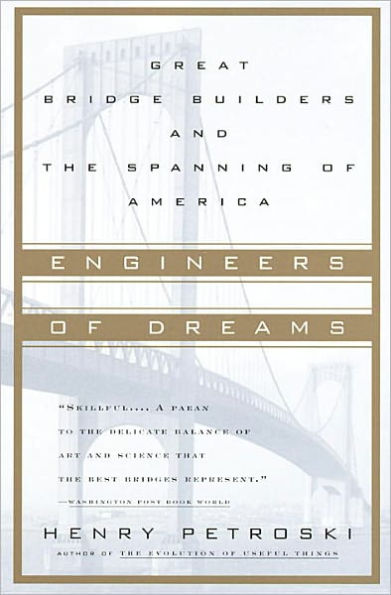Engineers of Dreams: Great Bridge Builders and the Spanning of America
Petroski reveals the science and engineering--not to mention the politics, egotism, and sheer magic--behind America's great bridges, particularly those constructed during the great bridge-building era starting in the 1870s and continuing through the 1930s. It is the story of the men and women who built the St. Louis, the George Washington, and the Golden Gate bridges, drawing not only on their mastery of numbers but on their gifts for persuasion and self-promotion. It is an account of triumphs and ignominious disasters (including the Tacoma Narrows Bridge, which literally twisted itself apart in a high wind). And throughout this grandly engaging book, Petroski lets us see how bridges became the "symbols and souls" of our civilization, as well as testaments to their builders' vision, ingenuity, and perseverance.
"Seamlessly linked...With astonishing scope and generosity of view, Mr. Petroski places the tradition of American bridge-building in perspective."--New York Times Book Review
"1100619624"
"Seamlessly linked...With astonishing scope and generosity of view, Mr. Petroski places the tradition of American bridge-building in perspective."--New York Times Book Review
Engineers of Dreams: Great Bridge Builders and the Spanning of America
Petroski reveals the science and engineering--not to mention the politics, egotism, and sheer magic--behind America's great bridges, particularly those constructed during the great bridge-building era starting in the 1870s and continuing through the 1930s. It is the story of the men and women who built the St. Louis, the George Washington, and the Golden Gate bridges, drawing not only on their mastery of numbers but on their gifts for persuasion and self-promotion. It is an account of triumphs and ignominious disasters (including the Tacoma Narrows Bridge, which literally twisted itself apart in a high wind). And throughout this grandly engaging book, Petroski lets us see how bridges became the "symbols and souls" of our civilization, as well as testaments to their builders' vision, ingenuity, and perseverance.
"Seamlessly linked...With astonishing scope and generosity of view, Mr. Petroski places the tradition of American bridge-building in perspective."--New York Times Book Review
"Seamlessly linked...With astonishing scope and generosity of view, Mr. Petroski places the tradition of American bridge-building in perspective."--New York Times Book Review
14.99
In Stock
5
1

Engineers of Dreams: Great Bridge Builders and the Spanning of America
496
Engineers of Dreams: Great Bridge Builders and the Spanning of America
496
14.99
In Stock

Product Details
| ISBN-13: | 9780307773135 |
|---|---|
| Publisher: | Knopf Doubleday Publishing Group |
| Publication date: | 12/15/2010 |
| Sold by: | Random House |
| Format: | eBook |
| Pages: | 496 |
| File size: | 14 MB |
| Note: | This product may take a few minutes to download. |
About the Author
From the B&N Reads Blog
